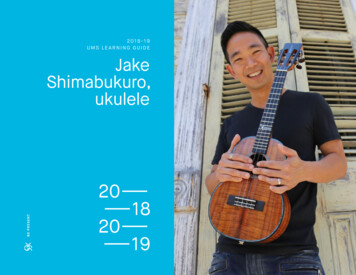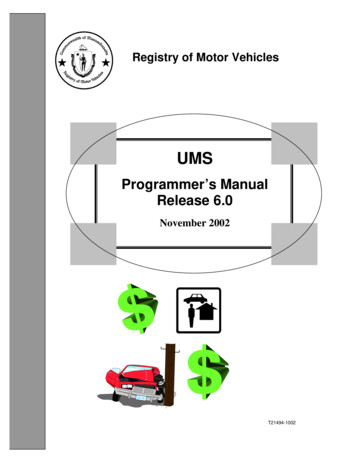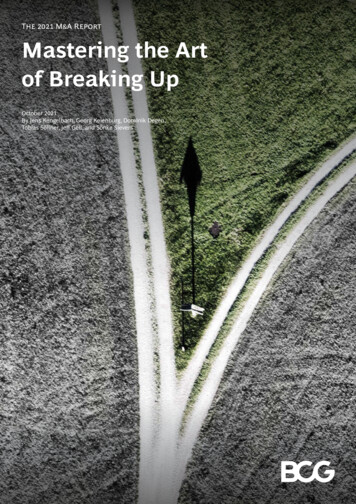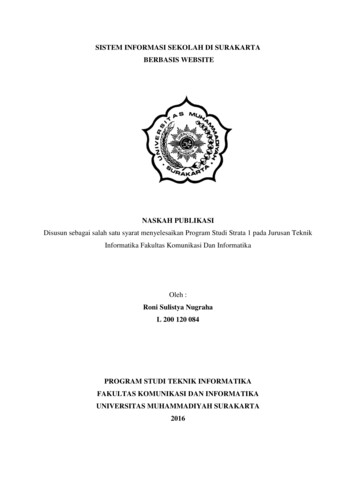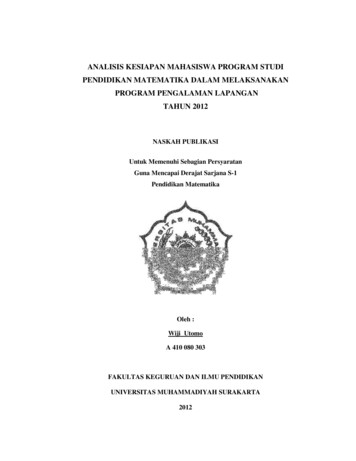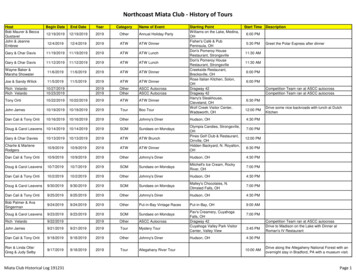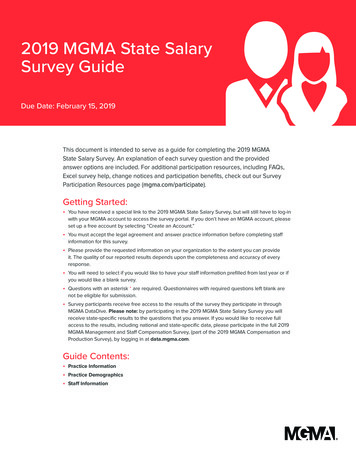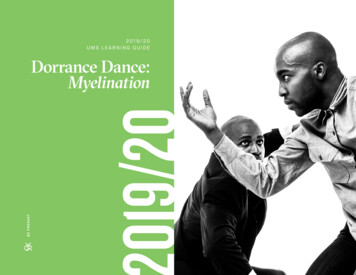
Transcription
2019/20UMS LEARNING GUIDE019/20BE PRESENTDorrance Dance:MyelinationBE PRESENT1
Table of Contents0405AT TENDTHE istArt FormPerformanceBeing an Audience MemberArts OnlineRecommended ReadingWriting About Live PerformanceAbout UMSCredits and Sponsors
October 17-18U M S S C H O O L D AY P E R F O R M A N C EDorrance Dance:MyelinationFriday, February 21, 2020 // 11 amPower CenterBE PRESENT3
AttendComing to your email Inbox!Map and Driving DirectionsLogistical Details (drop-off/pick-up locations)Venue Information7 3 4 . 7 6 4 . 2 5 3 8 ——— U M S . O R GBE PRESENT4
The DetailsACCESSIBILIT YWe aim to maximize accessibility at our performances and below are detailsregarding this performance’s points of accessibility. If you have furtherquestions, email umsyouth@umich.edu or call 734.615.0122.The following services are available to audience members: Wheelchair, companion, or other special seating Courtesy wheelchairs Hearing Impaired Support SystemsVENUE ADDRESSPower Center, 121 Fletcher St, Ann Arbor, MI 48109EMERGENCY CONTACT NUMBER734.764.2538ARRIVAL TIMEBetween 10:30-10:50 amTICKETSWe do not use paper tickets for School Day Performances. We hold schoolreservations at the door and seat groups upon arrival.FOODFood (including school lunches), drinks, and chewing gum are not allowed inthe theater.PARKINGThere is handicapped parking very close to the Power Center on Fletcher Streetand in the parking structure behind the Power Center on Palmer Drive. The firstthree levels of the Palmer Drive structure have five parking spots on each levelnext to each elevator. There are a total of 15 parking spaces in the garage.WHEELCHAIR ACCESSIBILIT YThe Power Center is wheelchair accessible and has 12 seats for audiencemembers with special needs.BATHROOMS ADACompliant toilets are available in the green room (east corner) of the PowerCenter for both men and women.ENTRYThe front doors are not powered; however, there will be an usher at that dooropening it for all patrons.CELL PHONESWe ask that all audience members turn off their cell phones during theperformance.BE PRESENT5
LearnDorrance DanceU M S . O R G ——— 7 3 4 . 6 1 5 . 0 1 2 2BE PRESENT6
LEARNWhy?U M S E D U C AT I O N A R T I S T I C S TAT E M E N TDorrance Dance is an award-winning tap dance company based out of New YorkCity. The company’s work aims to honor tap dance’s uniquely beautiful history ina new, dynamic, and compelling context; not by stripping the form of its tradition,but by pushing it forward rhythmically, technically, and conceptually. Thecompany’s inaugural performance garnered a Bessie Award for “blasting openour notions of tap,” and the company continues its passionate commitment toexpanding the audience of America’s original art form.Michelle Dorrance, the company’s founder and choreographer, advocates fortap’s acceptance in the academy and on the concert stage while recognizing itshistory and origins in the devastating conditions of slavery. “I think tap dance isan incredibly transcendent form,” says Dorrance. “It is born of some of the mostoppressed people our country and culture has known and finds its way to joy.”Dorrance’s approach to choreography involves complex movements and frequentcollaboration with musicians, other choreographers, and audio engineers. Uponawarding Dorrance a 2015 “Genius Grant,” the MacArthur Foundation wrote,“Dorrance maintains the essential layering of rhythms in tap but choreographsensemble works that engage the entire body: dancers swoop, bend, leap, andtwist with a dramatic expression that is at once musical and visual.”UMS is thrilled to present the stunning intersection of movement, sound, rhythm,and music with Dorrance Dance.BE PRESENT7
LEARNWhy?ONLINE: CONNECTING TO THE PERFORMANCEOnline: Getting to KnowMichelle DorranceVIDEO: PBS NewsHour ProfileBE PRESENT8
LEARNArtistDORRANCE DANCE: FIVE THINGS TO KNOW010203Michelle Dorrance, whose mother is aprofessional ballet dancer and teacher,began studying ballet at the age of three inChapel Hill, NC. Dorrance quickly gravitatedtowards tap and began performing withher local tap ensemble at an early age.She later toured with the off-Broadwayproduction of “Stomp the Yard” beforeturning her focus to choreography.Dorrance Dance’s work aims to honortap dance’s uniquely beautiful history ina new, dynamic, and compelling context,not by stripping the form of its tradition,but by pushing it forward rhythmically,technically, and conceptually. Thecompany’s inaugural performancegarnered a Bessie Award for “blastingopen our notions of tap” and thecompany continues its passionatecommitment to expanding the audienceof tap dance, America’s original art form.Dorrance premiered the original 16-minute versionof Myelination at New York City Center’s 2015Fall for Dance Festival. Two years later, Dorrancedeveloped a new, evening-length version of thework featuring 12 company dancers, 8 musicians,and original music by composers/musiciansDonovan Dorrance and Gregory Richardson.0405Dorrance’s work Myelination comes from a biology term referring to the process of a myelinsheath forming around a nerve, allowing nerve impulses to move more quickly. This conceptmanifests in the choreography, as Dorrance creates a dynamic road map of increasingly quickfooted movement that is just as musical as it is visually enticing. Beginning with fleetingduets, the choreography morphs into energetic and powerful segments with the entireensemble of dancers delivering fast unison footwork. The choreography and music acceleratein tandem as the dancer’s musical footwork blends with an original musical accompaniment.Michelle Dorrance promotes tap both in theacademic world and in mainstream culture.Following her 2015 MacArthur “Genius” Award,Dorrance brought tap to mainstream audiencesby performing her choreography on The LateShow with Stephen Colbert. Dorrance even taughtColbert a simple tap sequence to great success!BE PRESENT9
LEARNArtistONLINE: GET TING TO KNOW MICHELLE DORRANCEAdditional Resources:VIDEO: Dorrance Dance Show and Tell[1 hour 40 min lecture/demonstration]VIDEO: “How tap dancing was made inAmerica” by Vox MediaBE PRESENT10
LEARNArt FormTA P D A N C EORIGINS OF TAP DANCETap dance originated in the United States in theearly 19th century at the crossroads of African andIrish American dance forms. When slave owners tookaway traditional African percussion instruments,slaves turned to percussive dancing to expressthemselves and retain their cultural identities. Thesestyles of dance connected with clog dancing fromthe British Isles, creating a unique form of movementand rhythm. Early tap shoes had wooden soles,sometimes with pennies attached to the heel andtoe. Tap gained popularity after the Civil War as a partof traveling minstrel shows, where white and blackperformers wore blackface and belittled black peopleby portraying them as lazy, dumb, and comical.EVOLUTION OF TAP DANCE20th Century TapTap was an important feature of popular Vaudevillevariety shows of the early 20th century and a majorpart of the rich creative output of the HarlemRenaissance. Tap dancers began collaborating withjazz musicians, incorporating improvisation andcomplex syncopated rhythms into their movement.The modern tap shoe, featuring metal plates(called “taps”) on the heel and toe, also came intowidespread use at this time. Although Vaudevilleand Broadway brought performance opportunities toAfrican-American dancers, racism was still pervasive:white and black dancers typically performedseparately and for segregated audiences. Tap’spopularity declined in the second half of the century,but was reinvigorated in the 1980s through Broadwayshows like 42nd Street and The Tap Dance Kid.Tap in HollywoodFrom the 1930s to the 1950s, tap dance sequencesbecame a staple of movies and television. Tap starsincluded Shirley Temple, who made her film tapdance debut at age 6, and Gene Kelly, who introduceda balletic style of tap. Fred Astaire, famous forcombining tap with ballroom dance, insisted that hisdance scenes be captured with a single take and widecamera angle. This style of cinematography becamethe norm for tap dancing in movies and television fordecades.Tap TodayTap continues to be an important part of Americanvernacular dance. Modern tap dancers are informedby the traditions, movements, and styles of theirpredecessors while continuing to push the limitsof their art form. Tap is also gaining long-deservedrecognition on the concert stage, at major dancefestivals, and in university classrooms.BE PRESENT11
LEARNArt FormDANCEMOVEMENTChoreography is the series or combination of movements that creates these fundamental patterns in time and space. Like words in a sentence, theindividual movements are just as important as the product of their combination. In dance there are many different types of movement. Here are someoptions to explore as you think about dance.T YPEDEFINITIONSustainedAn even release of energy that stays constant, either fast or slow, but not both.PercussiveSudden bursts of energy that start and stop quickly.SwingingA drop of energy into gravity that sustains and follows through.SuspendedThis is the movement at the end of a swing, before gravity takes over.CollapseA sudden and complete release of energy, like fainting and either of the full body or a single body part.ExplosiveA gathering of energy that is released as a burst of one huge sudden action, either of the full body or a single body part.BE PRESENT12
LEARNArt FormDANCEELEMENTSThe elements of dance — easily remembered with the use of the acronym BEST: Body, Energy, Space, and Time — can be helpful guides in watchingor thinking about dance. (Cornett, C. (1999). The Arts as Meaning Makers. Pearson Education, Inc.)BODYENERGYSPACETIMEParts:Head, shoulders, elbows, hands, knees, feet, etc.Force:Smooth or sharpLevel:Low, middle, highRhythm:Pulse, beatIsolation:Movements restricted to one area of the bodysuch as the shoulders, rib cage or hipsWeight:Heavy or lightLevels:The height of the dancer in relation to the floor.When a dancer is at a low level, a part of historso might touch the floor; when a dancer is ata high level, he might be in the air or on his toesSpeed:Pace, tempo, rateDirection:Forward, backward, up, down, sidewaysDuration:Fast/slow, short/longSize:Large or smallPhrases:Dance sentences, patternsand combinationsShapes:Curved/angular, small/large, flat/roundedActions:(Non-locomotor) Stretch, bend, twist, rise, fall,circle, shake, suspend, sway, swing, collapse or(Locomotor) walk, run, leap, hop, jump, gallop,skip, slideLocomotor:Movements that occur in general space when adancer moves place to placeNon-locomotor:Movements that occur in a person’s space withone body part anchored to one spot and that areorganized around the spine or axis of the bodyStrength:Tight or relaxedFlow:Sudden or sustained, boundor freeAccent:Light or strong emphasisDestination:Where a dancer movesPathways:Patterns we make with the body on the floor andin the airFocus:Where a dancer looksBE PRESENT13
LEARNArt FormMaster Juba (ca. 1825–ca. 1852) was one of the only early black tapdancers to tour with a white minstrel group and one of the first toperform for white audiences. Master Juba offered a fast and technicallybrilliant dance style blending European and African dance forms.Bill “Bojangles” Robinson (1878–1949) began dancing in minstrelshows and was one of the first African-American dancers to performwithout blackface. He adapted to the changing tastes of the era,moving on to vaudeville, Broadway, Hollywood Radio programs, andtelevision. Robinson’s most popular routine involved dancing up anddown a staircase with complex tap rhythms on each step.Clayton “Peg Leg” Bates (1907-98) continued to dance with afterlosing a leg in a cotton gin accident as a child. He danced invaudeville, on film, and was a frequent guest on The Ed Sullivan Show.Bates also frequently performed for others with physical disabilities.H I S T O R Y : TA P M A S T E R SThe Nicholas BrothersFayard (1914-2006) and Harold (1921-2000) Nicholas had a filmand television tap career spanning more than 70 years. Impressedby their choreography, George Balanchine invited them to appearin his Broadway production of Babes in Arms. Their unique style ofsuppleness, strength, and fearlessness led many to believe that theywere trained ballet dancers.Gregory Hines (1946-2003) introduced a higher complexity of theimprovisation of steps, sounds, rhythms. Hines’s dances wererhythmically involved and often strayed from traditional rhythmic meters.Savion Glover (b. 1973) is best known for starring in the Broadwayhit The Tap Dance Kid. Glover mixes classic moves like those of histeacher Gregory Hines with his own contemporary style. He has wonseveral Tony awards for his Broadway choreography.Jeni Le Gon (1916-2012) was one of the first black women to becomea tap soloist in the first half of the 20th century. She wore pants ratherthan skirts when she performed and, as a result, she developed anathletic, acrobatic style, employing mule kicks and flying splits, morein the manner of the male dancers of the time.BE PRESENT14
LEARNArt FormTA P D A N C E T E R M I N O L O G YTap dances are comprised of different combinations of basicmoves. Read about some of these building blocks and try them outfor yourself!Toe: Strike the floor with the toeHeel: Strike the floor with the heelHeel Toe: Strike the floor with the heel, immediately followed by astrike of the toeBrush: While standing on one leg, sweep the other leg across thefloor (known as a “spank” when the free leg sweeps backwards)Scuff: Similar to a brush, but hitting the floor with the heel instead ofsweeping the shoeShuffle: The combination of two brushesFlap heel: A brush with on to the heel at the end of the brush motionBall change: A transfer of weight from the front foot to the ball of theback footBE PRESENT15
LEARNPerformanceDORRANCE DANCE“To be able to be a dancer and a musician at thesame time, there’s nothing like it There’s somethingorganic in your biorhythms, your heartbeat. And tobe able to demonstrate that inside of a moving formis phenomenal.” — Michelle DorranceBE PRESENT16
LEARNPerformanceDORRANCE DANCEDorrance DanceMyelinationMichelle Dorrance, artistic director and choreographerFriday, February 21, 2020 // 11 amPower CenterFounded in 2011 by MacArthur “Genius” Award recipientMichelle Dorrance, who has appeared with STOMP, Savion Glover,Manhattan Tap, and others, Dorrance Dance honors tap dance’suniquely beautiful history in a new and dynamically compellingcontext, pushing it forward rhythmically, aesthetically, andconceptually. The New York Times called Dorrance “a brilliantconductor [who] pushes the boundaries of tap while exposing itstrue nature: that it is music.”BE PRESENT17
LEARNPerformanceONLINE: DORRANCE DANCEDorrance Dance will perform thepiece Myelination at the School DayPerformance. Watch this video tolearn more about Michelle Dorrance’screative process and the ideasbehind the piece.BE PRESENT18
ConnectBeing an Audience MemberArts OnlineRecommended ReadingWriting about Live PerformancesAbout UMS7 3 4 . 7 6 4 . 2 5 3 8 ——— U M S . O R GBE PRESENT19
CONNECTBeing an Audience Member No talking, unless audience participation is requested by the performers. Avoid fidgeting and moving around in your seat during the performance.Slumping sideways blocks the view for audience members behind you,and extra movements can be distracting to your neighbors. Do not take flash photography. The flash can be distracting to theperformers on stage. Turn off and put away cell phones and other electronic devices. If you need to cough during the performance, wait for the pausebetween movements of a piece or try to “bury” your cough in a loudpassage of music.AUDIENCE ETIQUET TE 101WHEN SHOULD I CLAP?The audience claps to welcome the performers as they come on stage.The audience also claps at the conclusion of each piece on theprogram, but not between movements of a single piece. This can betricky, because many musical works have several movements withpauses in between. A work’s movements will be listed in the program orannounced at the performance. Not sure when the piece is over? Watchthe conductor, who will lower their hands at the end of the piece.When in doubt, it’s always safe to wait and follow what the rest of theaudience does. If you need assistance, please speak to a UMS usher. Most importantly, relax and enjoy the performance!BE PRESENT20
CONNECTBeing an Audience MemberENGAGING WITH THE PERFORMANCEEncourage your students to engage with and reflect on the performanceby asking these questions:GLOSSARY: ELEMENTS OF PERFORMANCE How did the performance make you feel?Lighting – location of light, use of darkness, color, movement, light in theaudience What does this performance remind you of?Space – venue/building, stage, distance between objects How does this performance relate to where you live?Sound – sound created by voices or movements of performers andaudience members, the location of the sound (behind the stage oroffstage), use of musical instruments or recorded music During the performance, close your eyes and imagine a “mind movie”using the performance as a soundtrack. What did you see in your mind?Movement – movement of performers, images, objects, or audiencemembers; speed, size, or shape of movements Did the performance tell a specific story?People: What was the most memorable part of the performance for you? Do you have any questions about the performance? Dancers Actors Musicians Stage Crew Ushers Audience MembersBE PRESENT21
CONNECTConnecting to Other Art FormsIMAGEIMAGE essionNumber1943.100Dorrance Dance - MyelinationIn this woodcut, we seeyoung women and menpossibly dancing the jitterbug,a new dance at the time.Artist Elizabeth Olds workedduring the Great Depression;she was interested inhighlighting racial injustice,celebrating African Americans’cultural contributions, andexperimenting with artisticforms. We can imagine thatthe joy depicted in this printechoes the rhythm and energyin Myelination.TitleHarlem DancersArtist(s)Elizabeth OldsArtist NationalityAmerican (North American)Object Creation Date1939Medium & SupportWoodcut on paperDimensions10 1/16 in x 14 ⅛ in(25.56 cm x 35.88 cm)Founded in 2011 by MacArthur“Genius “Award recipientMichelle Dorrance, DorranceDance honors tap dance’suniquely beautiful historyin a new and dynamicallycompelling context, pushingit forward rhythmically,aesthetically, and conceptually.UMS is thrilled to be presentingDorrance Dance again onour School Day Performanceseries. Dorrance has appearedwith STOMP, Savion Glover,Manhattan Tap, and a host ofothers. Dorrance is “a brilliantconductor [who] pushesthe boundaries of tap whileexposing its true nature: that itis music.” (New York Times)Credit LineAllocated by theU.S. GovernmentCommissioned throughthe New Deal art projectsThe artwork was provided by the University Of Michigan Museum Of Art to connect to the 2019/20 UMS School Day Performance series. UMMA has a long tradition of service to K-12students and educators of Southeast Michigan. This work is currently on exhibition in the museum. For more information about the University of Michigan Museum of Art and theirprograms for youth, teens, teachers and schools, visit the UMMA website.BE PRESENT22
CONNECTArts Online: Explore and DiscoverSITES WE SUGGESTUMSums.orgNEW YORK PHILHARMONICnyphil.orgMICHIGAN RADIOmichiganradio.orgUMMAumma.umich.eduAMERICAN THEATREamericantheatre.orgPBS: PUBLIC BROADCASTING SERVICEpbs.orgTHE KENNEDY CENTER, NEW YORK TIMESnytimes.comANN ARBOR DISTRICT LIBRARYaadl.orgNPR: NATIONAL PUBLIC RADIOnpr.org2019-20 SCHOOL DAY PERFORMANCES: ARTIST WEBSITESISANGO ENSEMBLEisangoensemble.co.za/THE BELIEVERS ARE BUT BROTHERSjavaadalipoor.co.uk/babbDORRANCE DANCEdorrancedance.com/CHINEKE! ORCHESTRAchineke.org/MARIACHI VARGAS DE chi-vargasde-tecalitlan/BE PRESENT23
CONNECTRecommended ReadingThe following listing of literature for teens and youth was developed by the Ann Arbor District Library to connect to the 2019/20 UMS School Day Performance Series.All titles are in circulation at the library. For more information about the Ann Arbor District Library and their programs for youth, teens, teachers and schools, visithttps://www.aadl.org.KIDSIsango Ensemble: The Magic FluteMariachi Vargas de TecalitlánThe Magic Flute, by Christopher RaschkaPicture bookThis illustrated book for children retells the story of the Mozart opera, in whichthe noble Prince Tamino seeks the fair Pamina against a backdrop of the battlebetween darkness and light.The Best Mariachi in the World, by J.D. SmithPicture bookEveryone in Gustavo’s family is in a mariachi band — everyone except Gustavo,that is. They all play violins, trompetas and guitarrones. They all make wonderfulmusic in restaurants and at wedding parties. Gustavo would love to join theband, but he can’t play any of the instruments. What’s a wannabe mariachi todo? Follow Gustavo as he finds his place in the family mariachi band.Baby Mozart: A Concert for Little EarsCDMozart’s The Magic Flute adapted for young listeners.Sing Me a Story: The Metropolitan Opera’s Book of Opera Stories for Children,by Jane RosenbergPicture bookAn illustrated retelling of the plots of 15 well-known operas, includingThe Magic Flute.S is for South Africa, by Beverly NaidooPicture BookThis photograph-filled book presents an A to Z look at some of the people,places, items, and customs of South Africa.Dorrance DanceTot Tap: A fun-filled introduction to the world of tap dance for kids.DVDLearn basic tap dance moves in this instructional DVD for kids.Tasha the Tap Dance Fairy, by Daisy MeadowsFiction bookPart of the popular Rainbow Magic series, in this installment tap dance is usedto help a fairy recover a missing item from an evil goblin.Rap A Tap Tap, by Leo and Diane DillonPicture bookIllustrations and rhyme describe the dancing of Bill “Bojangles” Robinson, oneof the most famous tap dancers of all time.BE PRESENT24
CONNECTRecommended ReadingContinued.Chineke! OrchestraThe Walkabout Orchestra: Postcards from Around the World, by Chloé PerarnauPicture bookThe orchestra have an important concert to play but all of the musicians havegone walkabout! Help the maestro and his faithful assistant track them downusing clues from their postcards from all over the world. Learn about all of theinstruments in an orchestra as you find the musicians!Duke Ellington: The Piano Prince and His Orchestra, by Andrea Davis PinkneyBiographyThe Coretta Scott King Award-winning biography that recounts the career ofDuke Ellington, the jazz musician and composer who, along with his orchestra,created music that was beyond category.The Story of the Orchestra, by Robert LevineNonfiction bookThis book, accompanied by a CD, allows you to listen while you learn about theinstruments, music and composers who wrote the music in an orchestra.TEEN/ADULTIsango Ensemble: The Magic FluteThe Magic FluteDVDDirected by Ingmar Bergman, this Swedish film is a scintillating screen versionof Mozart’s beloved opera that showcases Bergman’s deep knowledge of musicand his gift for expressing it cinematically. This Criterion Collection film castssome of Europe’s finest soloists, and lovingly recreates the Baroque theaterof Sweden’s Drottningholm Palace to stage the story of the prince Tamino andhis zestful sidekick Papageno, who are sent on a mission to save a beautifulprincess from the clutches of evil.The Magic FluteCDThe London Philharmonic Orchestra plays Mozart’s opera.Sunlight & Shadow: A Retelling of The Magic Flute, by Cameron DokeyFiction bookA baby girl is born on the longest night of the darkest month of the year. Whenher father looks at her, all he sees is what he feared: by birth, by name, and bynature, she belongs to the Dark. So when Mina turns 16, her father takes heraway from shadow and brings her into sunlight. In retaliation, her mother lures ahandsome prince into a deadly agreement: If he frees Mina, he can claim her ashis bride. Now Mina and her prince must endure deadly trials — of love, fate, andfamily — before they can truly live happily ever after.BE PRESENT25
CONNECTRecommended ReadingContinued.The Operas of Mozart, by Robert GreenbergLecture DVDA discussion of Mozart’s most important operas, including a 45-minute lectureon The Magic Flute.THE BELIEVERS ARE BUT BROTHERSRadicalization: Why Some People Choose the Path of Violence,by Farhad KhosrokhavarNonfiction bookIn the wake of recent terrorist attacks, fears over ‘homegrown terrorism’have surfaced to a degree not seen since September 11, 2001. A soughtafter commentator in France and a widely respected international scholar ofradical Islam, Farhad Khosrokhavar has spent years studying the path towardsradicalization, focusing particularly on the key role of prisons.Two Sisters: A Father, His Daughters, and Their Journey into the Syrian Jihad,by Åsne SeierstadNonfiction bookA riveting story of two sisters’ journey to the Islamic State and the father who triesto bring them home. Åsne Seierstad puts the problem of radicalization into painfullyhuman terms, using instant messages and other primary sources to reconstruct afamily’s crisis from the inside. This is a relentless thriller and a feat of reporting withprofound lessons about belief, extremism, and the meaning of devotion.Hateland: A Long, Hard Look at America’s Extremist Heart, by Daryl JohnsonNonfiction bookAn in-depth analysis of the current threat from domestic terrorism and itsgrowing menace. Johnson throws a stark light on the darkest segments ofAmerican society and offers suggestions for dealing with their violent threats.Alt-Right: From 4chan to the White House, by Mike WendlingNonfiction bookMedia accounts to the contrary, the alt-right didn’t just burst out of nowherein 2016. They have been building their network quietly for years, using onlinebulletin boards and social media to spread a toxic hybrid of technologicalutopianism, reactionary philosophy, and racial hatred. Wendling traces the riseof the movement and the evolution of its ideas, and he introduces us to some ofits key figures.Mariachi Vargas De Tecalitlán100 Anos de MariachiCDMariachi music from the past century performed by various artists and groups.The Guilty, by Juan VilloroShort story collectionA brilliant prize-winning collection of stories that beautifully and hauntinglydescribes Mexican culture and ways of life, by Mexico’s most important living writer.BE PRESENT26
CONNECTRecommended ReadingContinued.Dorrance DanceChineke! OrchestraTap Dance History: From Vaudeville to FilmDVDThis film explores the history of tap dance from its beginnings to the modernday. Tap dance enthusiasts will especially enjoy the rare footage of tap dancingin films from the 1930s and 1940s.William Grant Still, by Catherine SmithBiographyWilliam Grant Still was dubbed “The Dean” of African-American composersand was the first African American to conduct a major American symphonyorchestra. He composed more than 150 works during his lifetime, including fivesymphonies and eight operas.What the Eye Hears: A History of Tap Dancing, by Brian SeibertNonfiction bookTap is both dancing to music and dancing as music. We don’t just watch it;we hear its rhythms and feel them in our muscles and bones. Like jazz, tapwas born in the United States. It’s a hybrid of jig and clog dancing from theBritish Isles and traditional folk dances brought from Africa by slaves. BrianSeibert’s history illuminates tap’s complex origins. He charts tap’s growth inthe vaudeville circuits and nightclubs of the early 20th century, chronicles itsspread to ubiquity on Broadway and in Hollywood, analyzes its post-World WarII decline, and celebrates its reinvention by new generations of American andinternational performers.Ellington & the Modern Masters: Music of African-American ComposersCDViolin Concertos by Black Composers of the 18th & 19th CenturiesCDI Got Thunder: Black Women Songwriters on Their Craft, by LaShonda BarnettNonfiction bookA collection of interviews Barnett conducted with Black female songwritersand composers, discussing their processes for songwriting, composing, andperforming.BE PRESENT27
CONNECTWriting About Live Performance With Your StudentsA LET TER TO PERFORMERSGrade Level: Elementary School Students (K-5)Students will compose a personal letter to a performer from theSchool Day Performance. The student will write about their feelings,observations, and questions from the performance. With a teacher’sassistance, students may send these letters to the performers.Once the performance is done, have students write down their notes,observations, and reflections. They will use these notes to help themwrite their letters.AFTER THE PERFORMANCEInstruct students to write a letter to the performers. In completing thisexercise, students should:BEFORE THE PERFORMANCEDiscuss the following with your students:1. Live Performances2. The Art Form3. The Artist4. Origin of the Art Form or Artist Use standard letter-writing conventions (“Dear ,” “Sincerely,”) Mention when and where the performance took place Use the notes they took to share their experiences, observations, andquestions with the performersDURING THE PERFORMANCETo help students organize their thoughts during the performance,encourage them to consider the following:I Notice.I Feel.I Wonder.BE PRESENT28
CONNECTWriting About Live Performance With Your StudentsTWO THUMBS UP: WRITING A PERFORMANCE REVIEWAFTER THE PERFORMANCEGrade Level: Middle and High School Students (6-12)Instruct students to compare their pre-performance notes to th
Dorrance Dance is an award-winning tap dance company based out of New York City. The company’s work aims to honor tap dance’s uniquely beautiful history in a new, dynamic, and compelling context; not by stripping the form of its tradition, but by pushing it
